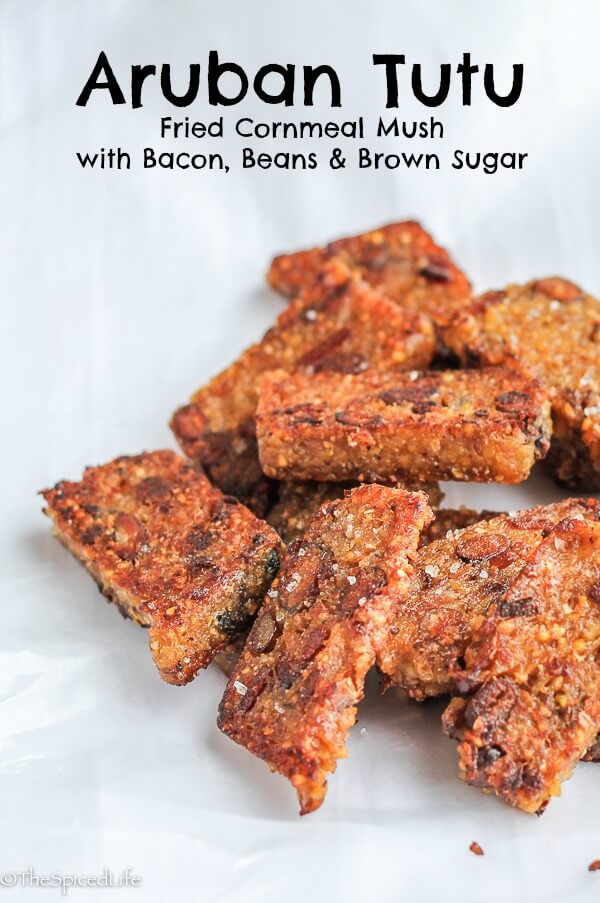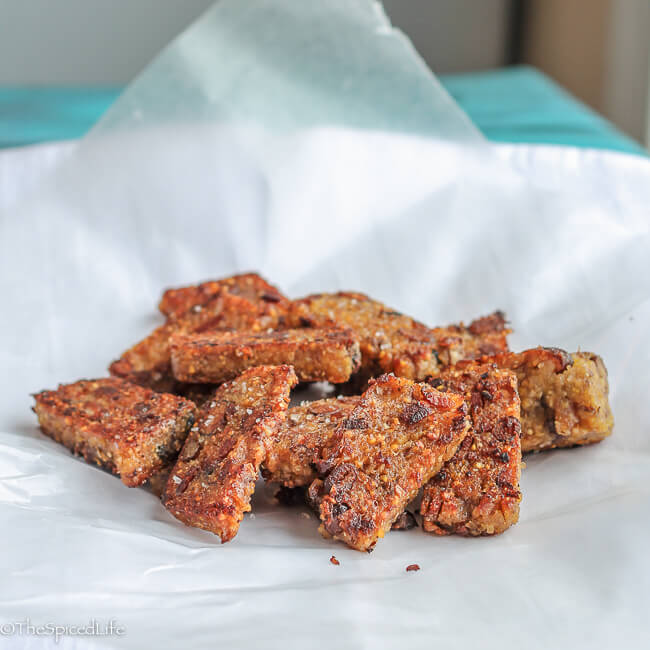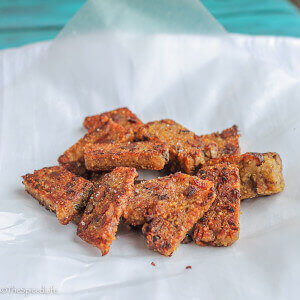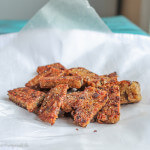Aruban tutu is a deliciously addictive fried cornmeal mush, or funchi, that has been enriched with beans, bacon and brown sugar. This hearty side can be served as part of breakfast or brunch, or as a delicious snack in the afternoon.

I had a total Blogger Fail this month and missed Bundt Bakers. I hope you go check them out–I am sure they are full of deliciousness!
In the meantime I am so backed up with my own store of goodies, that I had to share these tutu instead. And believe me they are worth it!
Tutu are a fancy kind of funchi made in Aruba. Let me guess, that cleared up nothing. Sammy’s Girl Scouts troop represented Aruba at the Girl Scout World Thinking Day, so we needed some Aruban treats. Aruba has very little native cuisine, because it has very little arable land, but it does of course have some traditional dishes. Funchi is a dish much like polenta, and much like polenta it can be served sliced and cold or sliced and then fried. But for fancier occasions, or occasions calling for more substance, there is a version of funchi called tutu, in which yummy goodies are mixed into the cornmeal mixture. We chose to make the tutu, because I was afraid the plain funchi might be a little bland served on its own instead of as an accompaniment.

So we fried up some tutu! And people this stuff is delicious. Like really addictive. It is not the prettiest stuff on the planet, and I would be lying if I told you many of the kids at World Thinking Day were willing to try it, but all their moms did and loved it! Sammy went crazy for it; Alex tried to act above trying it the next day (when I was frying up some leftovers for brunch) and then tried a little piece and also went crazy.
One note about the recipe. The recipe I was working from (linked to above) definitely did not require enough water or time to cook for my very coarse cornmeal. Next time I would choose a finer cornmeal or polenta (cornmeal marketed as polenta would probably be even better, but I did not have any). Basically the coarser the cornmeal that you use is, the longer it will take to cook, and the more additional water you may need to add.


- 1 cup dried beans, soaked overnight, black-eyed peas would be most traditional but I did not have any
- 2 cups water
- 2 cups coconut milk
- 2 cloves garlic, minced
- 8 slices of bacon
- 1 cup dark brown sugar, loosely packed
- 1 1/2 t salt
- 1 cup fine corn-meal
- 1-2 T unsalted butter for greasing pan
- 2-4 T unsalted butter
- 2-4 T bacon grease
- coarse sea salt for sprinkling
-
Place the beans into a pot and add the water and coconut milk. Bring to a boil and add the garlic. Cover and reduce the heat to maintain a gentle simmer.
-
Generously grease a 9x5 loaf pan with butter and set aside.
-
Cook the bacon until crispy, and then crumble and set aside. Reserve the bacon grease.
-
When the beans are mostly tender, add the brown sugar and stir it in. Add a little more water if the beans are not covered.
-
When the beans are completely tender, add the salt and the bacon. Gradually stir in the cornmeal and continue stirring until it thickens. It will become quite stiff and even pull away from the pan sides a bit. However, if your cornmeal is not super fine and is still crunchy, you will need to add more liquid (a few tablespoons at a time) and keep stirring. Mine took about 30-40 minutes and maybe an additional cup of water, but I was using coarse cornmeal.
-
When it is thickened and tender (for coarse cornmeal) or creamy (for fine), take it off the heat and spread it into your greased pan. Cover it with parchment paper, place a heavy plate or pan on the parchment paper, and place in the fridge to chill and set. I chilled it for about 20 minutes, but overnight is even better.
-
Remove the pan from the fridge and invert it onto a cutting board. Tap the bottom (which will be rightside up) to loosen and release the tutu. Slice it into 3/4-inch thick slices (I tripled the recipe and thus was using a very different pan--your slices may look different from mine.).
-
In the meantime, heat a tablespoon of butter and a tablespoon of the reserved bacon grease in a nonstick skillet. When they are quite hot, add several slices of the tutu--as many as you can add with whatever size pan you are using without crowding the pan.
-
Fry until deep golden brown on each side, I found it took about 3-4 minutes per side. Remove to a paper towel coated plate and immediately sprinkle with salt. Repeat until you have finished, adding more butter and bacon grease as needed (or store the leftovers to be fried the next day!).
-
Eat while warm.
Well I don’t know much about aruban cuisine, but give me some cornmeal and black beans and I’m there!
What an interesting recipe. I haven’t been to Aruba and loved reading about the recipe. My husband would go crazy for this one.
Ohhh Caribbean! I wonder do you think we could substitute out almond meal for the corn meal? I am very impressed and love cuisine from around the world!
My gut instinct is that any nut meal would be too heavy and oily. However, I think you could substitute any of the hot cereal grains (cream of wheat, cream of rice, the mixed grain hot cereals out there) and try those. The liquid amounts might vary. Please report back if you try with something other than cornmeal!
Laura,
What a great idea to celebrate Thinking Day! I like the idea of delving into a national cuisine–you got a good one to explore!
Anything fried up with bacon is good in my book, and this looks particularly yummy.
Thanks!
I had a friend who was from Aruba and she made the vegetarian version of this tutu. I think she called it something different, but, it was absolutely delicious. I have to try this. Is there a vegetarian option for the bacon?
I would think you could either a cooked and crumbled smoky and salty soyrizo or even just leave it out. If you do leave it out, you might experiment with less brown sugar and maybe add some smoked salt? Or even add something like chopped onions to the beans during the last 30 mins of cooking–anything to give it a more savory edge so the brown sugar does not overwhelm the beans and cornmeal. If you do experiment please let me know how it turns out!!
I’ve never been to Aruba, but anything with beans, coconut milk, and fried with bacon is tops in my book. I wouldn’t resist!
What a fascinating and novel dish. You are such a culinary adventurer.! 🙂 LOVE fried grits and polenta, but this takes the concept to new heights. So it’s savory, sweet, and loaded with umami and protein. I imagine any cooked bean would work here, perhaps even black lentils?
I would think so. I like the idea of some of the smokier ones, like a Rio Zape bean from Rancho Gordo.
what a really neat treat! This is the first time I have heard of it but it looks really great! 🙂
I’ve never heard of this before, but it looks amazing. Thanks for sharing!
I adore fried polenta but have never seen it with bacon before. This looks so amazing!
I’ve never heard of this kind of food, but it sure looks and sounds delicious. I found it on fridgg.com and saved it as a favorite that I want to try. Yum.
This looks so good! I’m definitely going to be given this a try!
Would like to correct you. Aruba does have a wider variety of local dishes than you assume or heard from someone or read another incorrect web page. If you don’t live here or experienced Aruba for real, don’t write incorrect information.
Thank you.
Yes I have been there, and I always research a country’s cuisine before sharing a dish. I re-read what I wrote and I would argue you are misunderstanding my point. I said Aruba has traditional dishes. But when all food (except seafood presumably) must be imported, there is no historical native (or national, but Aruba is not a nation, it is a constituent country of the Kingdom of the Netherlands) cuisine the same way.There are just waves of influences. And a base cuisine that is more receptive to those influences because they have to import the needed food for the dish anyway. The earliest settlers that we know of came around 1000 CE, Caquetios Indians from the Arawak tribe, which is much later than just about country I have made a dish from. One presumes before the Spanish got there around 500 years later that their diet was heavily seafood and sea vegetables complemented by some native foods of South America that could make the trip on the boats of the time. I meant no offense to Aruba, and as I made clear enjoyed the funchi tremendously. I also very much enjoyed visiting the country.